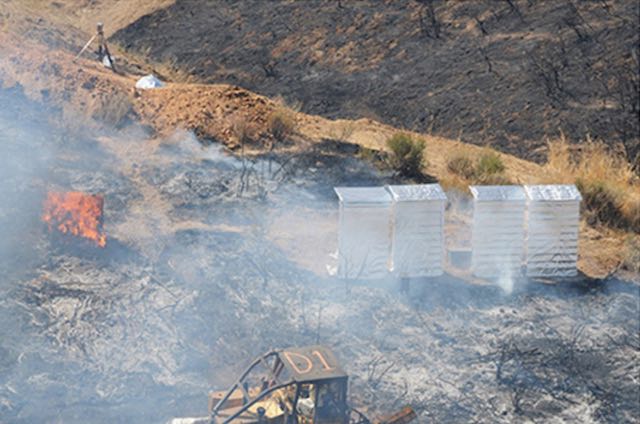According to the findings of the first study to conduct a scientific evaluation of this method of defense, encasing a structure in a fireproof blanket is an effective strategy to safeguard it against the spread of wildfires.
This research, which was published in Frontiers in Mechanical Engineering, confirms that existing blanket technology can protect structures from a short wildfire attack by rigorously testing different fabric materials in the laboratory and using them to shield structures that were exposed to fires of increasing magnitude.
The technological progress of blanket materials and deployment methods, in addition to multi-structure protection schemes, are both required for successful deployment against severe flames and in locations with a high housing density.
According to Fumiaki Takahashi, a professor at Case Western Reserve University and the primary author of the study, “the whole-house fire blanket is a practical means of protection against fires at the wildland-urban interface.” [Case Western Reserve University]
“The existing technique has the capability to defend a solitary building against a wildfire assault that lasts for only a relatively short period of time.
Future technical advancements are anticipated to make it possible for this strategy to be used to more extreme circumstances.”
Communities can be utterly destroyed by wildfires that occur in urban and suburban areas, which is one of the most significant concerns we face in terms of fire safety at this time.
People who live in and work in areas that are prone to fire have gotten in touch with Professor Takahashi to inquire about the availability of any commercial products that could help reduce the likelihood of a structure catching fire.
This would result in less property damage and an improved level of safety for both the general public and firefighters.
These appeals served as the impetus for the research, and the findings of the preliminary examination revealed that the idea of using fire blankets to protect entire buildings had been around for quite some time.

I was looking for a way to lessen the damage caused by wildfires when I came across an old United States patent for a “conflagration-retardative curtain,” sometimes known as a fire blanket.
This invention was issued during World War II. In addition, according to Takahashi’s report, firemen with the United States Woodland Service were able to save a historic forest cabin by encasing it in materials designed for use as a fire shelter.
In spite of the fact that there are anecdotal accounts indicating that fire blankets are capable of protecting buildings from flames, the research conducted by Takahashi revealed that there is a significant lack of scientific data to support these assertions.
In order to remedy this situation, the team carried out a series of experiments with the support of a research grant awarded by the United States Department of Homeland Security.
The purpose of these experiments was to evaluate the capacity of various blanket materials to protect structures from fires of increasing severity.
“The fire exposure experiments determined how well various wooden structures were protected by the fire blankets.
These structures ranged from a birdhouse in a burning room to a full-size shed in a real forest fire.
We examined the performance of four distinct kinds of fabric materials: aramid, fiberglass, amorphous silica, and pre-oxidized carbon, both with and without an aluminum surface coating.
In addition, we tested the heat-insulating capacities of these materials against direct flame contact or radiated heat by conducting experiments in a laboratory where the heat exposure was carefully regulated.
The assessments carried out in the laboratory as well as those carried out in real fires reveal that fire blankets have the potential to protect structures from a brief exposure to a wildfire.
However, these evaluations also emphasize the technical limits of their current form. In the fields of material composition, deployment methods, and multi-structure protection tactics, there is a need for further technological advancement.
According to Takahashi’s explanation, “The fiberglass or amorphous silica fabrics laminated with aluminum foil performed the best.”
This was owing to the fabric’s high reflection/emission of radiation as well as its strong thermal insulation.
In order to stop fires from spreading from one building to another, innovative technology is required to improve the fire blankets’ ability to block heat for an extended period of time.
In conclusion, he suggests that communities that could be impacted by wildfires collaborate in order to make the idea of whole-building fire blankets a reality.
According to the conclusions presented here, “the implication of the present findings is that the technological community, the general public, and the fire service must work together to take a step-by-step approach toward the successful deployment of this technology.” [Citation needed]
Post Views:
76
